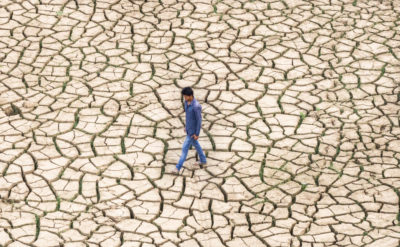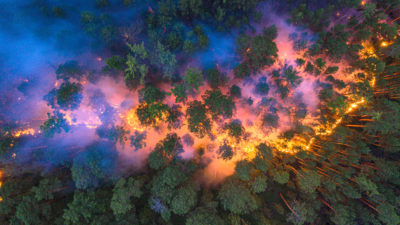Native climate negotiators meeting in Dubai last month pledged to chart a course for stabilizing the native climate system using good science. Nonetheless many scientists say these ensures are at most interesting ill-defined and at worst a travesty of nice science — imprecise and filled with loopholes.
The U.N. native climate conference in Dubai agreed on an movement plan for two key objectives: to take care of the world on observe to limit world warming to 1.5 ranges C (2.7 ranges F), and to stay beneath this threshold by reaching net-zero greenhouse gasoline emissions by 2050. Negotiators pledged that every objectives could possibly be pursued “in keeping with the science.”
Nonetheless neither of the objectives have agreed definitions that will allow a judgment on whether or not or not they’ve been achieved. Two analysis revealed via the Dubai event uncovered the difficulty and revealed massive gaps opening over every the 1.5-degree and net-zero targets, exposing the tensions between political expediency and scientific probity.
On the 1.5-degree aim, British meteorologists reported throughout the journal Nature {{that a}} lack of settlement on the way in which to measure world frequent temperatures is extra more likely to delay formal recognition that the brink has been exceeded by as a lot as a decade. The result, warns lead author Richard Betts of the U.Okay. Met Office’s Hadley Centre, will probably be “distraction and delay merely on the extent when native climate movement is most urgent,” resulting in temperature “overshoot” and a necessity for terribly pricey — and unproven — actions later to reverse warming.
Vital factors have been under the radar because of scientists have not wanted to naysay policymakers developing help for native climate movement.
Within the meantime a analysis headed by Matthew Gidden, an area climate modeler on the Worldwide Institute for Utilized Strategies Analysis (IIASA) in Austria, found that the foundations governing how nations can declare they’ve reached net-zero emissions are mounted so that governments shall be able to declare compliance years ahead of scientific actuality.
These important technical factors have been largely under the radar until now — partially, say concerned researchers, because of scientists have not wanted to confuse or naysay policymakers in search of to assemble public help for native climate movement. Nonetheless the discrepancies improve important questions on whether or not or not governments are literally devoted to abiding by the science. “Politicians are searching for a easy technique to fulfill their pledges,” talked about IIASA forest ecologist Dmitry Shchepashchenko.
However the urgency for resolving the uncertainties is rising. The earlier 12 months has seen the native climate system enter what researchers are calling “uncharted territory.” A few third of days in 2023 exceeded the 1.5-degree threshold, and September was 1.8 ranges hotter than preindustrial cases. The raw statistics translated into file wildfires in Canada and sea-ice loss spherical Antarctica, unprecedented summer season heatwaves from Arizona to southern China, and extreme floods in normally desert areas of North Africa.
The aim of capping world warming at 1.5 ranges C above preindustrial ranges first entered worldwide native climate policymaking by the use of the groundbreaking 2015 Paris Settlement. As part of the settlement, governments promised to take care of warming “correctly beneath 2 ranges,” whereas “pursuing efforts” to limit it to 1.5 ranges.
Since then, scientists have warned that any sustained warming above 1.5 ranges runs the risks of escalating dangerous local weather and inflicting elementary and irreversible shifts throughout the native climate system. So by the Dubai conference, it had become the unambiguous objective.
Nonetheless how will everyone knows if we now have saved beneath or exceeded it?
The U.N. World Meteorological Group reckons there is a two-thirds probability of a single 12 months exceeding the brink by 2027. Such a one-off would not by itself breach the agreed objective, which refers to long-term frequent temperatures. Nonetheless neither the Paris Settlement nor its successors set out how that long-term frequent must be calculated.
Scientists are concerned that the system agreed by negotiators for calculating offsets is contradictory and huge open to abuse.
Native climate scientists have traditionally assessed temperature developments averaged over the three earlier a few years. The U.N.’s Intergovernmental Panel on Native climate Change (IPCC), which assesses native climate science for the worldwide neighborhood, now favors twenty years. Nonetheless in each case, calculations based totally on newest earlier temperatures indicate the standard will on a regular basis lag behind actuality, saved low by the cooler early years of the interval. The outcomes acquired’t mirror the current situation, says Betts throughout the Nature article revealed via the Dubai conference.
In comply with, a 20-year frequent will mirror temperatures in the midst of that interval, says Betts. “1.5 warming could possibly be confirmed … a decade after crossing the 1.5-degree C diploma.”
So, if frequent warming reaches 1.5 ranges in 2030, the info will solely make amends for the end of the 20-year interval by which 2030 was the midpoint — 2040, in numerous phrases. Inside the intervening years, Betts says, there could possibly be “a decade or additional” of declare and counterclaim, with native climate scientists saying the world had nearly positively crossed the brink, nevertheless politicians able to deny it and declare they’ve additional time to cut emissions.
This ritual of denial was already on present in Dubai, in response to Piers Forster of the Faculty of Leeds, a lead author of various IPCC research. He elements out that the conference’s world stocktake settlement, which summed up movement plans to fulfill the Paris pledges, acknowledged that there had been 1.1 ranges of warming to date, based totally on a retrospective frequent, whereas the current precise frequent is spherical 1.3 ranges. Governments are “having fun with a political recreation to make 1.5 look additional potential,” Forster instructed Yale Environment 360.

A dried riverbed in Allahabad, India all through a 2014 drought.
Prabhat Kumar Verma / Pacific Press / LightRocket via Getty Pictures
Betts wants the IPCC to stop the subterfuge by adopting a “additional instantaneous indicator.” His paper suggests calculating the standard temperature by combining 10 years of historic temperatures with 10 years of model predictions of future temperatures. That may present controversial. Nonetheless for now, he says, “with out an agreed metric, there is perhaps no consensus on when the 1.5ºC diploma has been reached.”
The second drawback to the scientific integrity of the U.N. native climate negotiations is the way in which to evaluate progress on the ensures made by governments to appreciate net-zero emissions by 2050. The commitments require any continued greenhouse-gas emissions to be balanced by that date by human actions to grab equal portions, in forests or elsewhere. Nonetheless there could also be good concern amongst scientists that the system agreed by negotiators for calculating these “offsets” is contradictory and huge open to abuse.
The net-zero aim was first proposed by the IPCC. It was extensively adopted two years up to now on the Glasgow native climate conference, when 74 nations pledged to appreciate it, and enshrined throughout the Dubai settlement as a serious objective of native climate protection. Nonetheless there are two very completely totally different methodologies in use for calculating web zero: a scientific methodology utilized by IPCC scientists to measure carbon within the true world, and a rather a lot looser methodology adopted by negotiators and now included into U.N. native climate agreements.
Scientists and negotiators agree that solely managed forests must qualify as offsets. Nonetheless previous that, there could also be disagreement.
Gidden and totally different native climate scientists warn that this unfastened U.N. system for calculating offsets will fail to halt rising concentrations of greenhouse gases, leading to persevering with rising temperatures.
Most offsets being thought-about by governments comprise forest administration — sometimes dubbed nature-based choices to native climate change. Nonetheless deciding what carbon uptake in forests is anthropogenic — and so most likely qualifying as an offset in the direction of emissions — and what uptake is nature is troublesome, because of carbon is persistently being captured and launched naturally by forests.
Scientists and U.N. negotiators agree that solely forests that are straight managed must qualify as potential offsets. Nonetheless previous that, there could also be disagreement.
Beneath the IPCC technique, solely carbon captured by direct human actions in managed forests, paying homage to planting timber or reducing logging, must qualify. Carbon captured inside managed forests due to pure processes should not be counted, because it’s merely part of the pure biking of carbon between ecosystems and the ambiance.
Nonetheless the native climate negotiators have taken a particular technique. They’re saying that on the native scale it could be nearly unimaginable to distinguish clearly between what’s pure and what’s anthropogenic. So, they’ve solved the difficulty by allowing all carbon captured inside managed forests to qualify for offsetting in the direction of emissions.

Andrea Washington after pouring water on herself all through a heat wave in Austin, Texas in July 2023.
Brandon Bell / Getty Pictures
The outcomes from the two approaches is perhaps very completely totally different, Gidden’s analysis concluded. A number of the world’s good forests are at current capturing carbon on a giant scale, by the use of extra growth pushed by hotter and wetter conditions and the fertilizing affect of extra carbon dioxide throughout the ambiance. Beneath the U.N. pointers, this pure uptake inflates the amount of carbon that nations can offset in the direction of their emissions, which hastens their path to with the power to declare to have achieved web zero.
Gidden’s analysis found that the U.N. pointers allow governments to collectively offset between 4 and 7 billion tons of CO2 yearly from pure processes that do not qualify under the IPCC technique. This represents between 10 and 18 p.c of current complete fossil-fuel emissions, a decide he expects to rise extra between now and 2050.
Sincere adequate, some may say. If the carbon seize is precise, it would not matter whether or not or not the processes behind the seize are pure or anthropogenic. “The ambiance would not care the place the carbon dioxide comes from,” agrees Giacomo Grassi, a researcher on the European Price’s Joint Evaluation Centre, and a coauthor of the Gidden paper. Nonetheless, he gives, “the way in which wherein the land sink is counted as anthropogenic or pure nonetheless points to judge [policy] progress.”
Some analysts say the U.N. methodology on offsets is a wrecking ball that will destroy hopes of reaching actual web zero.
It points too because of the obligation of chopping emissions must be shared fairly, pretty than giving some well-forested nations a free journey. And since, Grassi argues, pure carbon-capture processes are nearly on a regular basis short-term and liable to enter reverse, notably as native climate change continues to hurry up.
Native climate change may at current be giving seize a elevate in a number of areas, nevertheless droughts, extreme temperatures, and fires may rapidly flip these carbon sinks once more into carbon sources. Definitely, scientists say, that is terribly potential. Gidden expects that after mid-century, forests at current capturing carbon will start releasing it as soon as extra in massive parts, creating a big shortfall in net-zero compliance.
The overall have an effect on of the unfastened U.N. pointers will allow the U.N. to “declare world net-zero emissions to have been achieved various years earlier than could possibly be the case in response to the IPCC definition,” says Chris Jones, a carbon-cycle analyst on the U.Okay. Met Office, who has reviewed the Gidden paper. Worse, they could declare success and not at all attain actual web zero.

An aerial view of a forest fire throughout the Krasnoyarsk space of Russia.
Julia Petrenko / Greenpeace
Completely different specialists on the carbon cycle go extra, saying the U.N. methodology is a wrecking ball that will destroy hopes of reaching actual web zero. It is “mainly writing a clear cheque for forested nations intent on persevering with to burn fossil fuels,” says Wolfgang Knorr, an ecologist at Lund Faculty, Sweden. He calls it an “accounting trick [that] will lastly current up as additional carbon dioxide throughout the ambiance and further warming. Nonetheless by the purpose all people realizes this, none of those accountable now will probably be in office.”
The excellence between the two carbon-accounting methods is massive in some nations. Russia, dwelling to larger than a fifth of the world’s timber, is at current seeing quick forest growth due to hotter temperatures. Most conservationists say its big forests all through Siberia are close to their pure state. They argue, as Shchepashchenko locations it, that in such areas “pure processes cannot be counted as being a outcomes of forest administration.”
Nonetheless Moscow sees points in one other means. It has declared most of these far-flung forests to be “managed,” and due to this fact that their carbon accumulation is reliable for offsetting in the direction of the nation’s carbon emissions. Russia’s newest revealed U.N. declaration on emissions subtracts a forest carbon sink of 540 million tons from the nation’s whole emissions of two.12 billion tons, reducing its declared “web” emissions by 1 / 4. Ministers have spoken of a wish to improve the definition of managed forests however extra to “maximize” their contribution to offsetting emissions.
Changes in carbon accounting must be included in reassessments of nationwide contributions to restore native climate change.
The U.S. simply is not so completely totally different. Some Japanese forests, notably throughout the Appalachians, are absorbing carbon at a fast cost, by the use of a mixture of pure regeneration after historic deforestation and the fertilization affect of elevated CO2 throughout the ambiance. Benefiting from this, submissions to the U.N. by the Environmental Security Firm offset 11.9 p.c of the nation’s greenhouse gasoline emissions in the direction of carbon uptake in forests and totally different managed lands. Nonetheless a analysis last 12 months by William Anderegg on the Faculty of Utah and colleagues highlighted a “hanging uncertainty” about how this decide may change going forward because of native climate change, along with “substantial risks of carbon losses … in areas the place forest carbon offset initiatives are at current positioned.”
Carbon modelers and native climate negotiators are seemingly at loggerheads. No matter its evident significance, Gidden says that “the have an effect on of this discrepancy on nationwide and world mitigation benchmarks continues to be not correctly understood.” Nonetheless it desires resolving, he says, if web zero is definitely to be achieved “in keeping with the science.” And shortly.
Grassi says that the outlet have to be mounted throughout the upcoming reassessments of nationwide contributions to fixing native climate change. These reassessments began in Dubai and are scheduled for completion in 2025, when delegates will meet in Belem on the sting of the Brazilian Amazon, the world’s largest rainforest.
Nations “ought to start the reassessments from corrected values,” Grassi says. In every other case, sometime in mid-century, merely when the world congratulates itself on reaching web zero, the carbon sinks on which the declare depends upon will disappear. Instantly’s “accounting trick” will probably be uncovered. Nonetheless too late.
